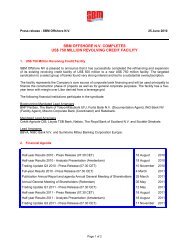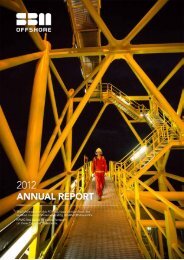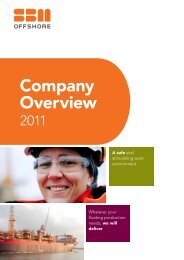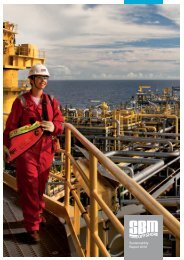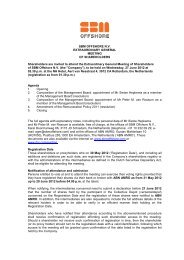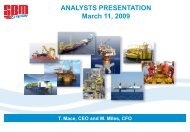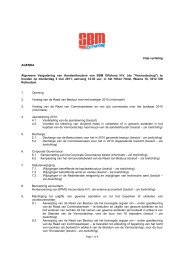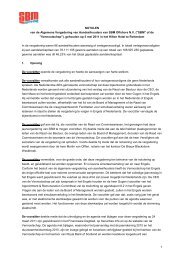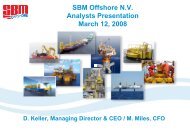Annual Report 2010 - SBM Offshore
Annual Report 2010 - SBM Offshore
Annual Report 2010 - SBM Offshore
Create successful ePaper yourself
Turn your PDF publications into a flip-book with our unique Google optimized e-Paper software.
Financial Review / Financial Statements <strong>2010</strong><br />
As set out in the paragraphs above, the Company aims<br />
by managing interest rate and currency risks to reduce<br />
the impact of short-term fluctuations on the Company’s<br />
earnings. Over the longer-term however, permanent<br />
changes in foreign exchange and interest rates would<br />
have an impact on consolidated earnings.<br />
Liquidity risk<br />
Liquidity risk is the risk that the Company will not be<br />
able to meet its financial obligations as they fall due.<br />
The Company’s approach to managing liquidity is to<br />
ensure, as far as possible, that it will always have sufficient<br />
liquidity to meet its liabilities when due, under<br />
both normal and abnormal conditions, without incurring<br />
unacceptable losses or risking damage to the<br />
Company’s reputation.<br />
Liquidity is monitored using rolling forecasts of the<br />
Company’s liquidity reserves on the basis of expected<br />
in thousands of US$<br />
Note<br />
cash flows. Flexibility is secured by maintaining availability<br />
under committed credit lines.<br />
The table below analyses the Company’s non-derivative<br />
financial liabilities and net-settled derivative<br />
financial liabilities into relevant maturity groupings<br />
based on the remaining period at the balance sheet<br />
date to the contractual maturity date. Derivative<br />
financial liabilities are included in the analysis if their<br />
contractual maturities are essential for an understanding<br />
of the timing of the cash flows. The amounts<br />
disclosed in the table are the contractual undiscounted<br />
cash flows. As of 31 December <strong>2010</strong>, the future interest<br />
cash flows for borrowings and derivative financial<br />
instruments are based on forecast Libor rates provided<br />
by primary info-providers. As of December 2009, the<br />
future interest cash flows for borrowings and derivative<br />
financial instruments were based on the year-end Libor<br />
rates.<br />
Less than 1<br />
year<br />
Between 1<br />
and 2 years<br />
Between 2<br />
and 5 years Over 5 years<br />
31 DECEMBER <strong>2010</strong><br />
Borrowings (ex finance lease liabilities) 320,111 442,649 1,076,324 176,583<br />
Finance lease liabilities - - - -<br />
Derivative financial instruments 48,861 48,602 94,637 67,157<br />
Trade payables 24 151,236 2,473 - -<br />
in thousands of US$<br />
Less than 1<br />
year<br />
Between 1<br />
and 2 years<br />
Between 2<br />
and 5 years<br />
Over 5 years<br />
31 DECEMBER 2009<br />
Borrowings (ex finance lease liabilities) 345,746 449,250 671,083 174,944<br />
Finance lease liabilities 8,841 8,841 37,984 -<br />
Derivative financial instruments 56,258 51,644 92,225 3,125<br />
Trade payables 199,380 1,850 - -<br />
170 <strong>SBM</strong> <strong>Offshore</strong> – <strong>Annual</strong> <strong>Report</strong> <strong>2010</strong>



